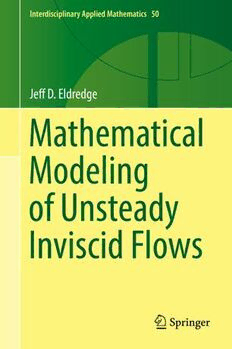Table Of ContentInterdisciplinary Applied Mathematics 50
Jeff D. Eldredge
Mathematical
Modeling
of Unsteady
Inviscid Flows
Interdisciplinary Applied Mathematics
Volume 50
Editors
AnthonyBloch,UniversityofMichigan,AnnArbor,MI,USA
CharlesL.Epstein,UniversityofPennsylvania,Philadelphia,PA,USA
AlainGoriely,UniversityofOxford,Oxford,UK
L.Greengard,NewYorkUniversity,NewYork,USA
Advisors
L.Glass,McGillUniversity,Montreal,QC,Canada
R.Kohn,NewYorkUniversity,NewYork,NY,USA
P.S.Krishnaprasad,UniversityofMaryland,CollegePark,MD,USA
AndrewFowler,UniversityofOxford,Oxford,UK
C.Peskin,NewYorkUniversity,NewYork,NY,USA
S.S.Sastry,UniversityofCaliforniaBerkeley,CA,USA
J.Sneyd,UniversityofAuckland,Auckland,NewZealand
RickDurrett,DukeUniversity,Durham,NC,USA
Moreinformationaboutthisseriesathttp://www.springer.com/series/1390
Jeff D. Eldredge
Mathematical Modeling of
Unsteady Inviscid Flows
123
JeffD.Eldredge
MechanicalandAerospaceEngineering
UniversityofCalifornia,LosAngeles
LosAngeles,CA,USA
ISSN0939-6047 ISSN2196-9973 (electronic)
InterdisciplinaryAppliedMathematics
ISBN978-3-030-18318-9 ISBN978-3-030-18319-6 (eBook)
https://doi.org/10.1007/978-3-030-18319-6
MathematicsSubjectClassification:76G25,76B99
©SpringerNatureSwitzerlandAG2019
Thisworkissubjecttocopyright.AllrightsarereservedbythePublisher,whetherthewholeorpartof
thematerialisconcerned,specificallytherightsoftranslation,reprinting,reuseofillustrations,recitation,
broadcasting,reproductiononmicrofilmsorinanyotherphysicalway,andtransmissionorinformation
storageandretrieval,electronicadaptation,computersoftware,orbysimilarordissimilarmethodology
nowknownorhereafterdeveloped.
Theuseofgeneraldescriptivenames,registerednames,trademarks,servicemarks,etc.inthispublication
doesnotimply,evenintheabsenceofaspecificstatement,thatsuchnamesareexemptfromtherelevant
protectivelawsandregulationsandthereforefreeforgeneraluse.
Thepublisher,theauthors,andtheeditorsaresafetoassumethattheadviceandinformationinthisbook
arebelievedtobetrueandaccurateatthedateofpublication.Neitherthepublishernortheauthorsor
theeditorsgiveawarranty,expressorimplied,withrespecttothematerialcontainedhereinorforany
errorsoromissionsthatmayhavebeenmade.Thepublisherremainsneutralwithregardtojurisdictional
claimsinpublishedmapsandinstitutionalaffiliations.
ThisSpringerimprintispublishedbytheregisteredcompanySpringerNatureSwitzerlandAG.
Theregisteredcompanyaddressis:Gewerbestrasse11,6330Cham,Switzerland
ForMina,Alex,andDaphne.
Preface
Inthismoderneraofreadyaccesstocomputationalresources,bothforresearchand
forinstruction,potentialflowtheoryhasbecomesomewhatofanendangeredspecies.
Though the subject persists in most undergraduate- and graduate-level aerospace
and mechanical engineering curricula, a typical course covers only the most basic
aspects and generally culminates in steady flows past streamlined planar bodies,
settingthefoundationforclassical(steady)aerodynamicsinstruction.Theassociated
courseworktendstoconsistofcontrivedproblemsadaptedfrommagicallyattached
flowspastcircularcylindersthateventheinstructorisatalosstoexplaintherelevance
of.Itisnosurprise,then,thatastudentoftenleaves such aclasswondering about
the modern relevance of potential flow. Indeed, even experienced researchers tend
todismissitasahistoricallegacy.However,itispreciselybecauseofitstruncated
treatment that even well-respected researchers and practitioners of fluid dynamics
haveadoptedaratherdimviewofthesubjectofinviscidflows.
But the true utility of inviscid fluid dynamics—both to illuminate fundamental
concepts and toserveas thefoundation forpractical modeling—only emerges just
pastthispointoftruncation,whenthesubjectisextendedtounsteadyflows.Inthat
context,theflowpastacircularcylinderfinallydisplaysoneofitsvirtues:outfitted
withconformaltransformations,wecandevelopthisbenignflowintotheflowpast
any closed planar body. By adding a few simple tools in the circle plane and the
transportrulesforvortexelements,wecanconstructanendlessvarietyofphysically
plausible unsteady models. Even the potential flow generated by the cylinder has
animportantphysicalrole,forifthecylinderisacceleratedfromrestinaquiescent
fluid, the flow that it develops at its first instant is entirely potential. Furthermore,
in unsteady inviscid flows, we have a powerful milieu from which to understand
and distinguish a variety of fundamental concepts in flow physics: flows induced
by moving bodies, the influence of added mass, vortex–vortex and vortex–body
dynamics,andtheassociatedforces,moments,andenergetics.
It must be emphasized that the subject of unsteady inviscid flows is as rele-
vant as ever, providing a foundation from which to analyze the dynamics of agile
aerial and aquatic vehicles, the performance of wind turbines and other devices
thatharvestenergyfromfluidflows,andthelocomotionoflargecreaturesinfluid
vii
viii Preface
media.Furthermore,thetoolswedevelopinthissubjectenableuniqueinsightinto
interactinggroupsofsuchsystems—schools,swarms,andwindfarms.
Themannerinwhichinviscidflowmodelsareusedhasevolvedinrecentyears.
Inthe1970s–1990s,numericalcodesbasedoninviscidmodelswereincommonuse
in the design of aircraft, based on complex panelizations of the fuselage and wing
system. This is still the case, but there is now a heavier reliance on higher-fidelity
analysisfromcomputationalfluiddynamics(CFD).Incontrast,inviscidflowmodels
are increasingly used in a data-driven capacity, wherein the flow model serves as
a dynamical template: the model describes the underlying dynamical evolution of
the flow, but unspecified parameters of the model are obtained from experiments
orCFDbymeansofdataassimilationormachinelearning.Theresultingreduced-
ordermodelisthereforeadistillationoftherealflowphysicsandmightserveasthe
backboneofaflowestimationand/orcontrolstrategy,forexample.
Therefore,thepurposeofthisbookistoextendtheinstructionofpotentialflow
theorytothisrichermoderncontext.Myobjectiveinwritingthebookhasbeento
make this extended treatment accessible to as broad an audience as possible and
tohighlight thepowerfulsetoftoolsthatitprovides forexploring fluiddynamics.
The book consolidates various mathematical tools and theoretical frameworks for
describing the physics of unsteady inviscid flows, particularly in the context of
lifting and propulsive surfaces. Though many of these tools are classical, others
are relatively recent. It is important to add that this book focuses exclusively on
bodiesimmersedinunboundedhomogeneousfluidmedia,generating(orsubjected
to) incompressible flow; it does not contain detailed treatments of internal flows,
compressibleflows,orflowswithfreesurfacesorfluid-fluidinterfaces,asidefrom
theirbasicgoverningequations.
In many university courses, three-dimensional inviscid flows, even the steady
ones, are treated only briefly (e.g., to establish the basis for lifting-line theory) or
skipped altogether due to time constraints. However, it is illuminating to see the
relationships between two-dimensional and three-dimensional concepts, so wher-
ever possible, I simultaneously present concepts in both contexts. With a slightly
liberalizednotation,itisquiteeasytowriteequationsthatholdinbothdimensions.
Forflowsintheplane,Ihavedevotedaparticularattentiontounifyingthevector
andcomplexapproaches.Mostbookschooseoneortheotherandtherebylosethe
opportunitytohighlighttheinherentconnectionsbetweentheseapproaches.Many
students who feel comfortable with a vector-based presentation of potential flow
tendtobeabitapprehensiveofthecomplexanalysisoftheproblem.Thus,Ihave
takenspecialcarethroughoutthebooktodemonstratehowtomovefluidlyfromone
perspectivetotheother.Whereverpossible,formulasarepresentedinbothforms.
ExpectedLevelofPreparation
Inaperfectworld,aninstructorwouldexpandthepotentialflowmodelingsection
of a class to accommodate this extended material. However, such an expansion is
practicallyimpossible,sinceitwouldrequiretrimmingsomeotheressentialsubject
tofitwithinafixedacademicterm.Thus,myprimarypurposehasbeentocreatea
Preface ix
resourceforself-directedstudy,onewhichprovidesanopportunityforstudentstogo
attheirownpacebeyondthetypicalgraduate-levelclass(oradvancedundergraduate
class)onpotentialflow.
While writing this book, I have imagined the reader to be a mature graduate
student who has already completed a graduate-level course on inviscid flows. In
other words, the reader is already familiar with the foundations of potential flow,
buthasprobablyonlyseenitappliedtosimplesteady(two-dimensional)flowspast
bodies and perhaps a few elementary unsteady motions (e.g., of point vortices). A
reader with an aerodynamics background will likely be accustomed to a bit more,
suchasthinairfoiltheoryandliftinglines,butagain,thisislikelytobeinasteadyflow
setting.Itispossibleforareadertoproceeddirectlytothisbookfromanintermediate
undergraduatefluidmechanicsclass.However,mostofthefoundationalconceptsare
onlysummarizedinChap.3,withthepresumptionthatthisonlyservesasareview.
Thereadershouldhavethemathematicalpreparationtypicalofanundergraduate
engineeringcurriculum.Thoughthemathematicalanalysisisextensiveinthisbook,
Ihavetriedtoensurethatitisaccessibletoareaderwhoisonlymodestlyinclined
towardmathematics.Ihavealsostriventomakeitasself-containedaspossible,so
that the reader can avoid looking up or learning about mathematical topics from
othersources.Therefore,theAppendixofthebookcontainsanextensivesummary
andbriefdiscussionofallofthemathematicalresultsessentialforthisbook.These
includebasictheoremsfromvectorcalculusandtheirconsequences,definitions,and
conceptsfromcomplexanalysisandsomeusefulintegrals.Theyalsoincludesome
nonstandardfare,suchastimedifferentiationofvolume,surface,andlineintegrals.
SomeNotesonNotation
Because of the extensive collection of symbols used in this book, I have taken
particularcaretoorganizethenotationalongafewrules.Thevariablesofrealand
complex scalar quantities are denoted with italics, such as x and z. Vector- and
tensor-valuedquantitiesarerepresentedwithbolditalics,likex,v,orM.Thearrays
oftheircomponentsinsomecoordinatesystemare,incontrast,denotedwithbold
sansserif:xandv,forexample.
OtherSources
There is a variety of references from which I have drawn the material presented
in this book. For basic inviscid flow theory, I recommend the book of Karamcheti
[38].Foramuchdeepersourceofmaterialonthesubject,particularlyinitsuseof
complexanalysis,IamquitefondofthebooksbyMilne-Thomson[53,52].Lamb’s
classicbook[43]isanabsolutetreasureofusefulresults,manyofwhicharesadly
neglected by modern textbooks. For a thoughtful discussion of the foundations of
x Preface
steady aerodynamics, particularly on the suitability of the Kutta condition (or, by
hisattribution,theJoukowskihypothesis),IsuggestGlauert’sbook[26].Anderson’s
text [4] has become a modern classic and provides an accessible introduction to
aerodynamics.Aeroelasticitytheoryhasbeen,historically,themostsignificantmo-
tivationforstudyingunsteadyaerodynamics,andIrecommendtheclassicbookby
Bisplinghoff, Ashley, and Halfman for this subject and its thorough treatment [8].
Onthesubjectofvortexdynamics,bothinviscidandviscous,Ihighlyrecommend
thecompacttreatmentofSaffman’sbook[63].ThebookbyKatzandPlotkin[39]
providesanexcellentresourceontheuseofnumericalmethodsforpotentialflows
andshouldberegardedasapractitioner’sguidetocomplementthemoremathemat-
icaltreatmentofthepresentbook.Vortexparticlemethodshavealsomaturedinto
an attractive tool for high-fidelity numerical simulation of viscous external flows,
andthebookbyCottetandKoumoutsakos[14]servesasaverygoodreferencefor
theirimplementation.
LosAngeles,CA,USA JeffD.Eldredge
April2019

